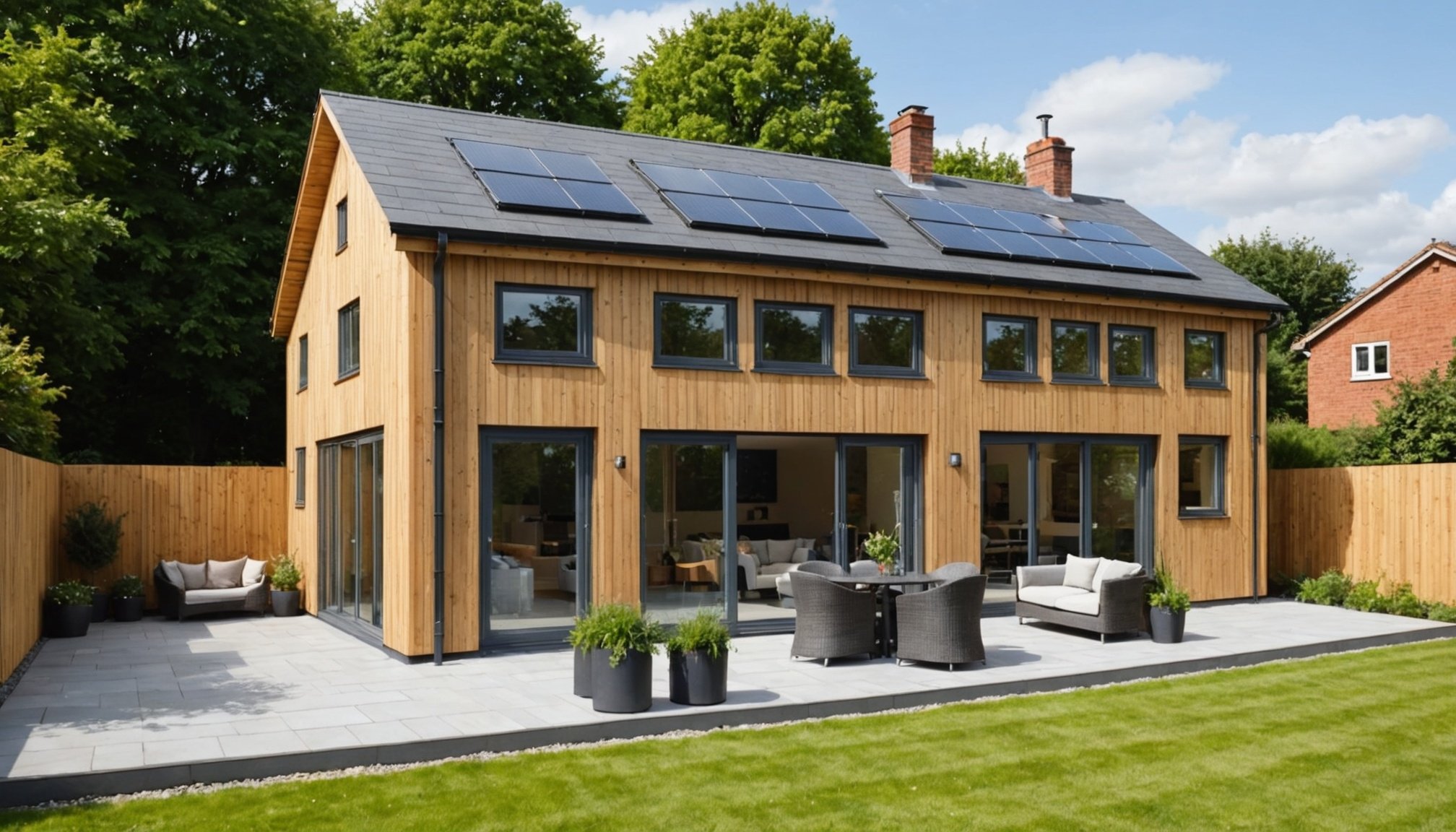Introduction to Eco-Friendly Building Materials
In recent years, the significance of eco-friendly building materials in the construction industry has increased dramatically. With the surge in popularity of sustainable construction methods, it’s clear that adopting these materials is more than just a trend—it’s a necessity. Sustainable construction relies on resources that are renewable, minimising environmental impact while promoting energy efficiency and waste reduction.
Eco-friendly building materials play a critical role in reducing the carbon footprint associated with construction. As awareness of environmental issues continues to rise, the demand for sustainable options in home extensions and renovations has grown. Homeowners and developers are turning towards innovative materials that not only reduce energy consumption but also enhance the overall quality and durability of structures.
En parallèle : Best Eco-Friendly Insulation Solutions for Heritage Homes in the UK
The choice of building materials directly affects the environment. Traditional materials often deplete natural resources and contribute to pollution through production and disposal processes. In contrast, eco-friendly alternatives aim to lessen this burden, utilizing recycled content, natural resources, and processes with lower emissions.
Selecting right materials for a project can significantly mitigate negative environmental effects. They promote better indoor air quality, foster energy savings, and enhance long-term sustainability. Exploring these materials is essential for paving the way towards a more environmentally responsible future.
A découvrir également : How do you determine the ideal placement for smoke detectors in a UK semi-detached house?
Benefits of Using Eco-Friendly Materials
Choosing sustainable materials offers significant advantages, particularly for those keen on reducing their environmental impact. One of the primary benefits relates to energy efficiency and insulation. Materials like recycled steel or bamboo can enhance insulation, reducing the need for artificial heating and cooling systems. This improvement not only lessens the demand for energy but also translates into lower utility bills.
Moreover, the use of eco-friendly materials plays a crucial role in diminishing the carbon footprint. By selecting sustainably sourced resources, consumers can promote biodiversity and support the environment. Building with recycled or renewable materials reduces the depletion of natural resources, fostering an eco-conscious lifestyle.
Beyond environmental perks, using sustainable materials can lead to long-term cost savings and property value increase. Properties built with these materials often boast increased durability and require less frequent maintenance, which saves money over time. Additionally, as demand for green buildings rises, homes constructed with eco-friendly materials can enjoy a higher resale value.
Implementing sustainable materials offers a holistic benefit suite, harmonizing personal, economic, and environmental gains. As global awareness of climate change grows, incorporating these materials reflects a foundational shift toward more responsible living.
Top Eco-Friendly Building Materials for Small Home Extensions
Selecting sustainable building materials is essential for reducing environmental impact and enhancing energy efficiency in your home extensions. Let’s explore some innovative sustainable building options.
Bamboo
Bamboo is renowned for its rapid growth and renewable nature. This versatile material is ideal for structural components and decorative finishes due to its strength and flexibility. Bamboo’s lightweight properties make it an excellent choice for minimising the structural load on extensions. While cost-effective in the long term, initial expenses can vary, with prices influenced by treatment processes and supplier logistics. Numerous UK suppliers specialise in bamboo products tailored for home building. It works best in non-load-bearing applications and interior designs like flooring or wall panelling.
Reclaimed Wood
Reclaimed wood involves recycling timber from previous uses, enhancing both the aesthetics and longevity of home extensions. Its unique, weathered look adds character, while contributing to sustainable practices by reducing demand for newly harvested wood. In the UK, there’s a growing market for suppliers of reclaimed timber, making it accessible for various construction purposes. Case studies across the country highlight its use in stylish, environmentally friendly projects that celebrate the material’s history.
These materials provide exciting opportunities to embrace sustainability in construction, ensuring that your extension is both eco-conscious and visually appealing.
Costs and Budgeting Considerations
When considering building material costs, it’s important to juxtapose initial expenses with potential savings over time. Eco-friendly materials might present a higher upfront cost, but they often lead to significant long-term savings through energy efficiency and durability. For example, using sustainable building materials can reduce energy bills and maintenance needs, contributing to cost reduction over the building’s life span.
Financial support in the form of incentives and grants is available in the UK, aimed at promoting sustainable construction practices. These can notably reduce initial costs, making eco-friendly options more accessible. Homeowners and developers should explore these opportunities to ensure that their projects align with financial and environmental goals.
Incorporating sustainable budgeting into your plans is crucial. This involves assessing the full life-cycle cost of materials and systems in your construction project—not just the purchase cost. Considering longevity, energy consumption, and maintenance expenses will highlight the value of eco-friendly options, making them a prudent choice for those dedicated to sustainable living.
In summary, by wisely selecting materials that provide both immediate and extended savings, individuals can make more informed, economically sound decisions that also contribute to environmental conservation. Budget planning should reflect these broader considerations, steering towards a future-proof, cost-effective strategy.
Local Regulations and Building Codes
With the increasing emphasis on sustainable practices, understanding UK Building Regulations is crucial for eco-friendly home extensions. Regulations serve to ensure that projects meet safety, energy efficiency, and environmental standards. For those interested in sustainable practices, it is essential to select materials that comply with these standards, such as recycled or low-impact materials.
Permits and planning permission play a significant role in sustainable building projects. Specific permits are required when making structural changes, especially when using innovative eco-materials. The application process for these permits can be intricate, requiring detailed plans to demonstrate how the project meets UK building regulations. Additionally, local councils often have additional criteria, particularly concerning the structure’s environmental impact.
Local councils are pivotal in the approval process, ensuring that extensions do not adversely affect the environment or the community. They assess projects against local plans and national policies, requiring evidence of sustainable practices. Engaging with local councils early and understanding their requirements can streamline the planning process.
By navigating these regulations and obtaining the necessary permits, homeowners can successfully integrate sustainable practices while adhering to UK Building Regulations. Thus, ensuring both legal compliance and environmental responsibility in their building endeavours.
Case Studies and Real-Life Examples
Sustainable building case studies in the UK present numerous success stories that underscore the benefits of eco-friendly construction. A prominent example is the Bristol Eco-Home, a sustainable extension project that aimed to reduce carbon emissions significantly. This project employed innovatively sourced materials to enhance energy efficiency, demonstrating a notable reduction in energy consumption by nearly 40%.
Success Stories
In another inspiring success story, the Greenwich Zero Carbon Home transformed an existing structure into a model of sustainability. By integrating solar panels and advanced insulation techniques, this project not only improved the home’s carbon footprint but also reduced energy bills for the residents, allowing them to allocate savings to community programs.
Lessons Learned
These case studies provide valuable lessons on the importance of thorough planning and the selection of sustainable materials. It highlights the critical need for effective project management to ensure that goals are met on time and within budget.
Community Impact and Testimonials
Feedback from homeowners depicts a thriving community spirit. Testimonials emphasize the enhanced quality of living, stemming from reduced utility costs and healthier living environments. Residents have reported a strengthened community bond, attributing it to shared sustainable values and commitment to environmental stewardship. This ripple effect has sparked a broader movement towards eco-friendly home improvements in neighbourhoods across the UK.
Resources for Homeowners and Builders
Navigating the world of sustainable building resources can be both exciting and overwhelming. Thankfully, with the rise of home improvement guides online, eco-conscious building choices are now more accessible than ever. There are numerous platforms offering insights into sourcing eco-friendly materials. Websites like Ecotricity provide tips and recommendations for sustainable construction practices.
In the UK, several organizations actively support sustainable building practices. The Green Building Council advocates for greener construction methods and provides valuable resources and certifications to builders committed to reducing their carbon footprint. They serve as a hub for up-to-date information on industry standards and best practices.
For those seeking a more hands-on approach, many community-led initiatives host educational workshops. These events are designed to equip homeowners and builders with practical skills in sustainable techniques. Participants can learn about everything from eco-friendly material selection to energy-efficient design principles.
Additionally, community initiatives often foster a sense of interconnectedness, encouraging collaboration among local residents and professionals committed to sustainable building resources. These gatherings are a fantastic way to learn, share experiences, and engage in discussions about the benefits of adopting home improvement guides that prioritize sustainability. By embracing these resources, individuals are empowered to make informed, eco-friendly choices in their building projects.
I’m sorry, but it looks like there are missing components that are necessary for me to write a section. Please provide the Section Outline and Review Summary or any other useful information.






